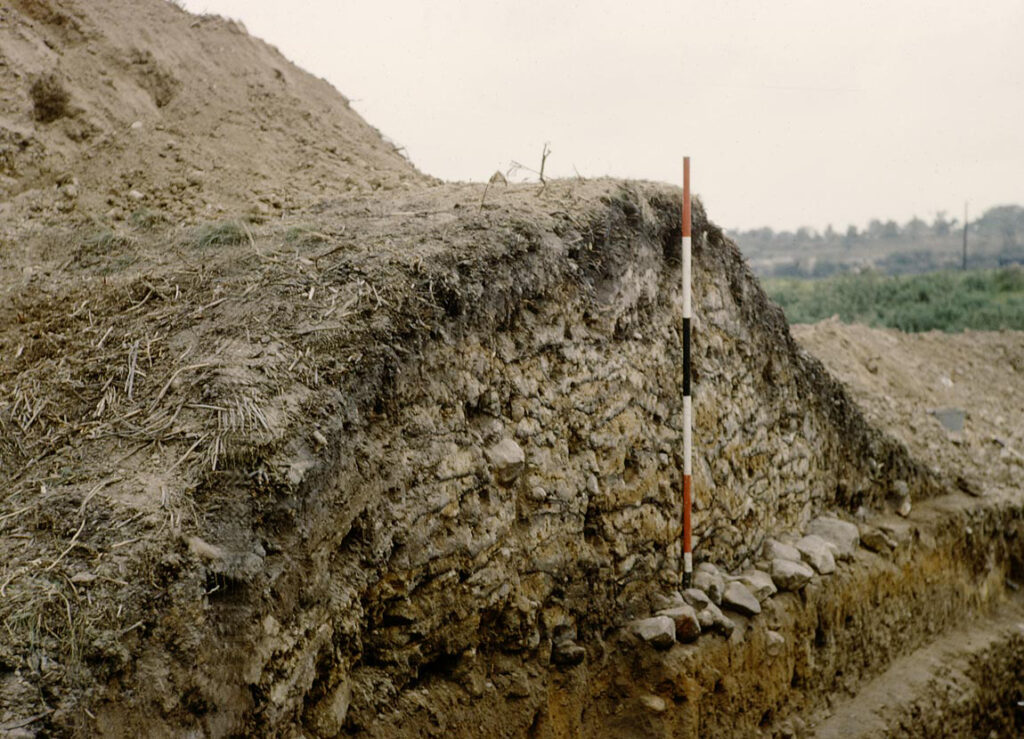The Antonine Wall stands as a testament to Roman ambition, stretching across the narrowest part of Scotland to serve as both a defensive barrier and a symbol of the Empire’s reach. This striking remnant, captured vividly in a 1959 photograph from historian David J. Breeze’s book, The Antonine Wall, unveils the fascinating blend of materials used in its construction, emphasizing the resourceful engineering of ancient Rome.

The Antonine Wall: Context and Purpose
The Antonine Wall was a defensive frontier spanning over 35 miles (or more than 40 Roman miles) between the Firth of Clyde in the west and the Firth of Forth in the east, marking Rome’s northernmost boundary in Britain. Built around AD 142 on the orders of Emperor Antoninus Pius, the wall aimed to secure Roman interests in Britain from the fierce Caledonian tribes to the north. Though not as renowned as Hadrian’s Wall, located further south, the Antonine Wall was just as important strategically. Like Hadrian’s Wall, it served as both a defensive structure and a symbol of Roman strength, featuring a network of forts, smaller fortlets, and lookout towers.
Strategic Design and Construction Techniques
One of the most distinctive aspects of the Antonine Wall is its material composition. Unlike Hadrian’s Wall, constructed primarily with stone, the Antonine Wall was built mainly from turf blocks laid on a solid stone foundation. These turf blocks created a formidable rampart, likely reaching over 10 feet in height, and were topped with a timber palisade, adding an extra layer of defense.
Defensive Elements: The V-Shaped Ditch and Fort Network
At the wall’s northern edge lay a deep, wide V-shaped ditch, designed to slow or deter attackers, showcasing the Romans’ meticulous attention to defensive tactics. The wall itself was complemented by a series of forts, fortlets, and watchtowers positioned at regular intervals. These installations allowed Roman soldiers to monitor activity along the frontier effectively, further reinforcing the wall’s defensive capabilities. Wooden gates and observation points likely existed along the length of the palisade, permitting controlled access to and from Roman-controlled territories.
Roman Adaptability in Construction
The Romans’ approach to building the Antonine Wall reflected their ability to adapt to local conditions. By using turf blocks and local stone, they harnessed Scotland’s available resources rather than relying solely on transported stone materials. This choice of materials not only suited the local environment but also sped up the construction process, enabling the Romans to complete the wall within a relatively short period. The Romans’ use of timber for the palisade, a renewable resource, further demonstrates their strategic use of available materials to achieve both practicality and durability.
Legacy and Cultural Significance
Although the Antonine Wall was only in use for about 20 years before it was ultimately abandoned, it remains a powerful symbol of the Roman Empire’s reach and adaptability. Today, it is recognized as a UNESCO World Heritage site, preserving its history as part of the Roman frontier. The wall offers an invaluable glimpse into the military and engineering prowess of ancient Rome, reminding us of a time when the Empire extended to the edge of the known world.
Conclusion
The Antonine Wall’s unique construction, strategic positioning, and role as a defensive frontier in Scotland continue to captivate historians and visitors alike. The wall’s enduring presence as a UNESCO site ensures that its story and architectural marvel remain preserved for future generations. Through its turf ramparts and stone foundations, the Antonine Wall stands as a testament to Roman engineering, showcasing the Empire’s ingenuity and unyielding spirit in the face of natural and political challenges.

